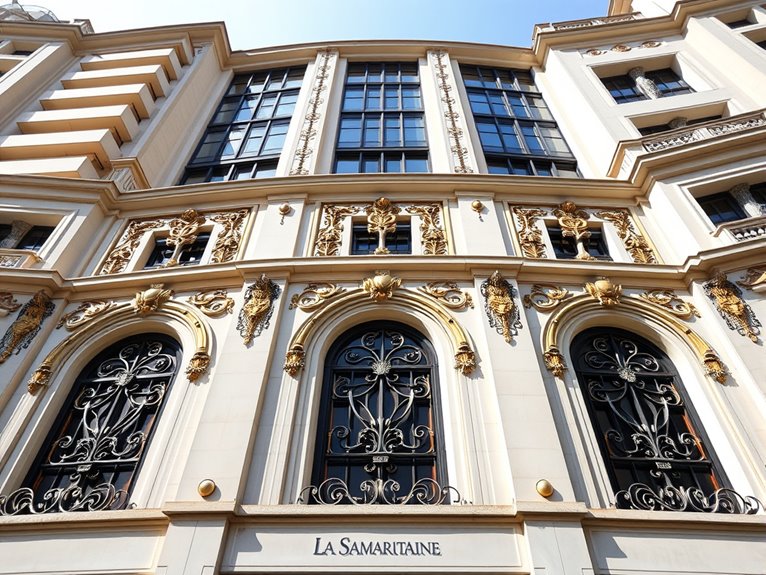
7 Stunning Art Deco Buildings in Paris to Admire
Paris's most stunning Art Deco buildings showcase the glamour of the 1920s and 30s! I've explored seven architectural gems you won't want to miss: the iconic Théâtre des Champs-Élysées, the magnificent Palais de Chaillot, the recently renovated La Samaritaine department store, the luxurious Piscine Molitor, the dazzling Folies Bergère, the historic Palais de la Porte Dorée, and the unique Église du Saint-Esprit. Each building tells a fascinating story of French artistic innovation and cultural transformation.
Théâtre Des Champs-Élysées
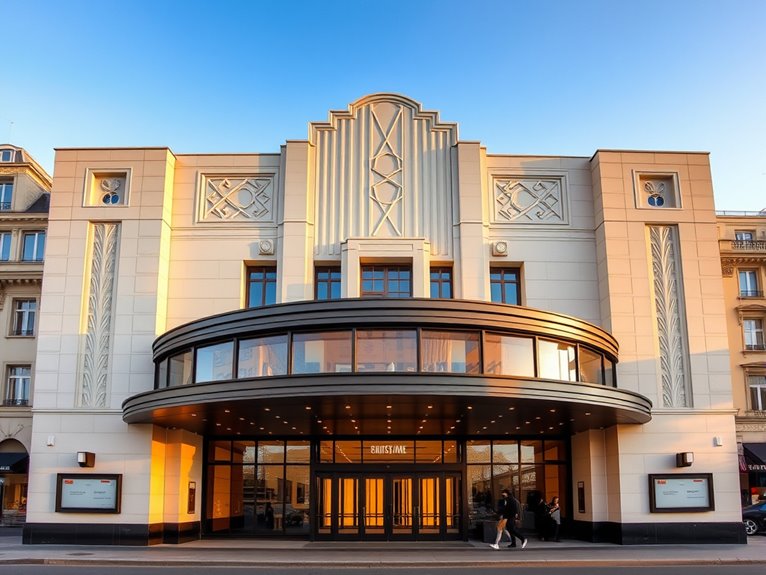
The Théâtre des Champs-Élysées stands as one of Paris's most significant Art Deco landmarks, representing a revolutionary departure from the ornate Beaux-Arts style that dominated French architecture in the early 20th century. Completed in 1913, this innovative structure was the first major building in Paris to be constructed primarily of reinforced concrete, marking a pivotal moment in architectural history and setting new standards for modern design.
This iconic theater has not only shaped architectural trends but has also played host to some of the most controversial and groundbreaking performances in artistic history. Most remarkably, it was here that Igor Stravinsky's "The Rite of Spring" premiered in 1913, causing a near-riot among audience members and forever changing the landscape of modern classical music and dance.
Quick Facts:
- Best visiting hours: 10:00 AM – 5:00 PM (guided tours)
- Ticket prices: €15-150 for performances, €12 for guided tours
- Photography: Allowed in lobby and exterior; restricted during performances
- Architecture tours: Available Tuesday-Saturday
- Accessibility: Elevator access to all levels
- Location: 15 Avenue Montaigne, 8th arrondissement
The theater's exterior showcases the work of brothers Auguste and Gustave Perret, who masterfully combined classical proportions with Art Deco details. The facade features elegant bas-reliefs by Antoine Bourdelle, depicting scenes from music and dance. The building's clean lines and geometric patterns establish it as a pioneering example of early Art Deco architecture, while its concrete construction demonstrates remarkable engineering innovation for its time.
The interior spaces are equally impressive, featuring sumptuous Art Deco details throughout. The main auditorium seats 1,905 spectators and is renowned for its exceptional acoustics. The ceiling boasts a remarkable dome painted by Maurice Denis, while the walls showcase works by Édouard Vuillard. Insider tip: The best acoustics can be found in the center of the first balcony, rows 3-5.
Pro Tips:
The ideal time to photograph the exterior is during the golden hour, just before sunset, when the play of light on the concrete facade creates dramatic shadows that highlight the architectural details. For interior tours, book the first morning slot (10:00 AM) to avoid crowds and get the best lighting for photos. Consider combining your visit with a pre-performance dinner at one of the many high-end restaurants along Avenue Montaigne.
Practical Advice:
Book performance tickets at least three months in advance for popular shows, especially during the peak season (September-December). The theater's location in the fashionable 8th arrondissement makes it easily accessible via Metro lines 1, 9, and 13 at Alma-Marceau or Franklin D. Roosevelt stations. Dress code is strictly enforced for evening performances: formal attire is expected, and sneakers or casual wear are not permitted.
Palais De Chaillot
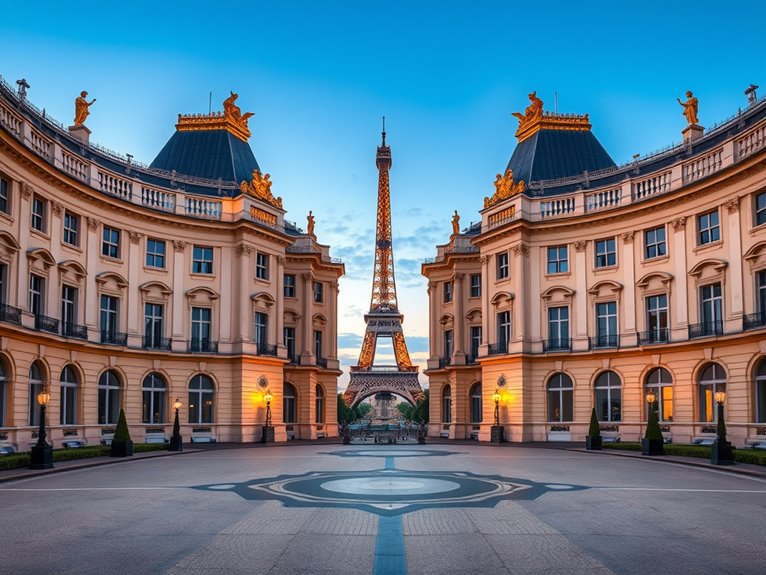
The Palais de Chaillot stands as one of Paris's most impressive examples of Art Deco architecture, commanding attention from its privileged position on the Trocadéro hill. Built for the 1937 International Exposition of Arts and Technology, this monumental structure replaced the former Palais du Trocadéro and has since become an iconic symbol of French architectural innovation during the interwar period.
This impressive complex, with its two curved wings embracing the Eiffel Tower view, houses multiple museums and cultural institutions while serving as a demonstration of France's artistic ambitions of the 1930s. The building's clean lines, geometric patterns, and modernist sculptures epitomize the Art Deco movement's aesthetic principles, making it an essential stop for architecture enthusiasts and casual visitors alike.
Quick Facts:
- Opening Hours: 10:00 AM – 6:00 PM (closed Tuesdays)
- Best Viewing Time: Late afternoon for ideal photography
- Photography: Permitted in most areas; tripods require permission
- Admission: Varies by museum (€5-12 per museum)
- Accessibility: Fully wheelchair accessible
- Guided Tours: Available in multiple languages (booking required)
The Museums
The Palais houses several prestigious institutions, including the Musée de l'Homme (anthropology), the Musée National de la Marine (naval history), and the Cité de l'Architecture et du Patrimoine. Each museum maintains its distinct character while respecting the building's Art Deco heritage. The museums' collections complement the architectural experience, offering visitors a thorough cultural journey.
The Architecture
The building's distinctive features include its massive colonnades, streamlined facades, and the famous esplanade offering panoramic views of Paris. The architects Jacques Carlu, Louis-Hippolyte Boileau, and Léon Azéma created a masterpiece of proportions, with the two wings spanning 184 meters each. Insider tip: The often-overlooked basement level contains original Art Deco details and decorative elements rarely seen by visitors.
The Sculptures
The exterior features remarkable sculptural work by multiple artists, including the allegorical figures "L'Homme" and "La Femme" by Carlo Sarrabezolles. These monumental pieces exemplify the Art Deco style's celebration of human form and progress. Lesser-known fact: The original golden sculptures from the 1937 exhibition were temporarily stored during WWII and later reinstalled.
Pro Tips:
For the best photographic opportunities, visit during "golden hour" just before sunset when the building's limestone facades take on a warm glow. The esplanade becomes less crowded after 4:00 PM, allowing for unobstructed views and photos of both the palace and the Eiffel Tower. Consider combining your visit with the Trocadéro gardens, which offer additional vantage points for architectural appreciation.
Practical Advice:
Purchase a combined ticket if planning to visit multiple museums within the palace. The site can be reached via Metro lines 6 and 9 (Trocadéro station). For the most rewarding experience, allocate at least half a day to explore both the architecture and museums. The cafeteria on the lower level offers reasonable prices and surprisingly good views, making it a convenient spot for a break between museum visits.
Piscine Molitor
The Piscine Molitor stands as one of Paris's most iconic Art Deco landmarks, a stunning demonstration of the golden age of 1920s leisure and luxury. Originally opened in 1929, this historic swimming complex earned its nickname "the white cruise liner" due to its striking nautical-inspired architecture and distinctive blue-and-white color scheme that embodied the glamorous spirit of its era.
After decades of glory, abandonment, and eventual rebirth, the Molitor has been meticulously restored to its former grandeur, reopening in 2014 as part of the MGallery Hotel Collection. Today, visitors can experience both its summer outdoor pool and winter indoor pool, surrounded by the same Art Deco splendor that once attracted Paris's elite, including notable figures like Johnny Weissmuller and the first revelation of the bikini in 1946.
Quick Facts:
- Opening Hours: 7:00 AM – 10:00 PM daily
- Admission: €180 for day passes (includes spa access)
- Best Time to Visit: Early morning for fewer crowds
- Photography: Permitted in designated areas only
- Dress Code: Proper swimming attire required
- Facilities: Two pools, spa, restaurant, rooftop bar
- Reservation: Required for non-hotel guests
- Temperature: Indoor pool heated year-round to 28°C
Main Pool Complex:
The outdoor pool, measuring 46 meters in length, remains the crown jewel of the complex. Three levels of Art Deco changing cabins painted in signature blue surround the pool, creating an amphitheater-like atmosphere. The restoration maintained original features like the glass ceiling and iron railings while incorporating modern amenities. Insider tip: Book a room at the hotel for unlimited pool access and better value if planning multiple visits.
Winter Pool:
The indoor pool features stunning stained-glass windows and intricate Art Deco motifs throughout. This 33-meter pool maintains its original architectural elements, including decorative pillars and mosaics. The space transforms into an elegant event venue during special occasions. Insider tip: Visit during off-peak hours (2:00 PM – 4:00 PM) for the best lighting for photos through the historic windows.
Pro Tips:
The Molitor experience is best enjoyed by combining pool time with other amenities. Consider starting with an early morning swim, followed by breakfast at the rooftop restaurant with panoramic views of Paris. For photography enthusiasts, the golden hour just before sunset creates magical lighting conditions that highlight the Art Deco details and cast beautiful reflections on the water.
Practical Advice:
Advance booking is essential, especially during summer months and weekends. While the day pass price may seem steep, it includes access to all facilities including the spa and fitness center. Consider visiting during shoulder season (March-May or September-October) for more comfortable temperatures and fewer tourists. Locker rooms provide toiletries and towels, but bringing your own swimming cap is recommended as they're mandatory for both pools.
La Samaritaine Department Store
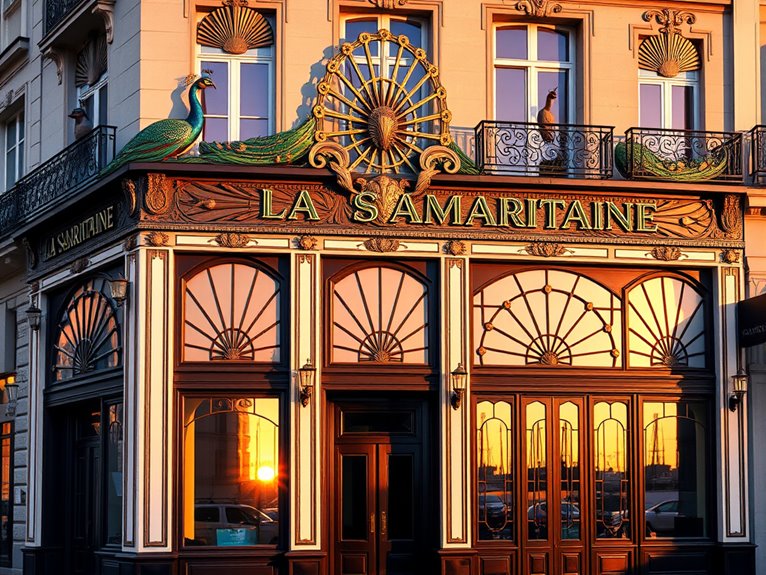
La Samaritaine stands as one of Paris's most striking examples of Art Deco architecture, combining the ornate stylings of the 1920s with contemporary luxury retail. Originally opened in 1870 and extensively renovated in 2021, this architectural masterpiece represents the golden age of Parisian department stores while embracing modern sophistication. The building's iconic facade features elaborate enameled tiles, decorative ironwork, and distinctive Art Deco lettering that has become a symbol of Parisian retail heritage.
The recent renovation by SANAA architects has masterfully preserved the building's historic elements while introducing contemporary design features, including an undulating glass facade that complements the original Art Deco structure. Visitors can explore 70,000 square meters of retail space spread across multiple buildings, featuring luxury boutiques, restaurants, and a boutique hotel, all while admiring the stunning architectural details that earned the building historical monument status.
Quick Facts:
- Opening Hours: 10:00 AM – 8:00 PM (Monday-Sunday)
- Best Time to Visit: Early morning or weekday afternoons to avoid crowds
- Photography: Allowed in common areas; restricted in some boutiques
- Price Range: Luxury retail (high-end)
- Closest Metro: Pont-Neuf (Line 7)
- Accessibility: Fully wheelchair accessible
- Guided Tours: Available by appointment
Architectural Highlights
The crown jewel of La Samaritaine's architecture is its magnificent glass roof and Art Nouveau peacock fresco, located in the central atrium. The restored iron and glass structure allows natural light to flood the interior, creating an ethereal shopping experience. The original staircase, with its intricate wrought-iron balustrades, showcases the craftsmanship of the Art Deco period. Insider tip: Visit during golden hour (around 4-5 PM in winter, 7-8 PM in summer) when the light filtering through the glass roof creates spectacular photo opportunities.
Modern Meets Heritage
The SANAA-designed wave-like glass facade on the Rue de Rivoli side demonstrates how contemporary architecture can harmoniously blend with historical elements. The rippling glass exterior reflects the surrounding cityscape while creating an innovative visual dialogue with the original Art Deco features. The renovation project also uncovered and restored original decorative elements that had been hidden for decades.
Pro Tips:
Start your visit at the top floor's Voyage restaurant for panoramic views of Paris. The restaurant's terrace offers unique perspectives of the Seine and city landmarks. Consider visiting during shoulder season (March-April or September-October) when tourist crowds are smaller, allowing for unobstructed views of the architectural details and more relaxed shopping experience.
Practical Advice:
While La Samaritaine is primarily a luxury shopping destination, the building itself is free to explore. Consider joining a guided architectural tour (book in advance) to access restricted areas and learn about hidden architectural details. The department store is busiest on weekends and during Paris Fashion Week, so plan accordingly. Storage lockers are available for visitors, and the concierge service can assist with tax-free shopping procedures for non-EU residents.
Folies Bergère
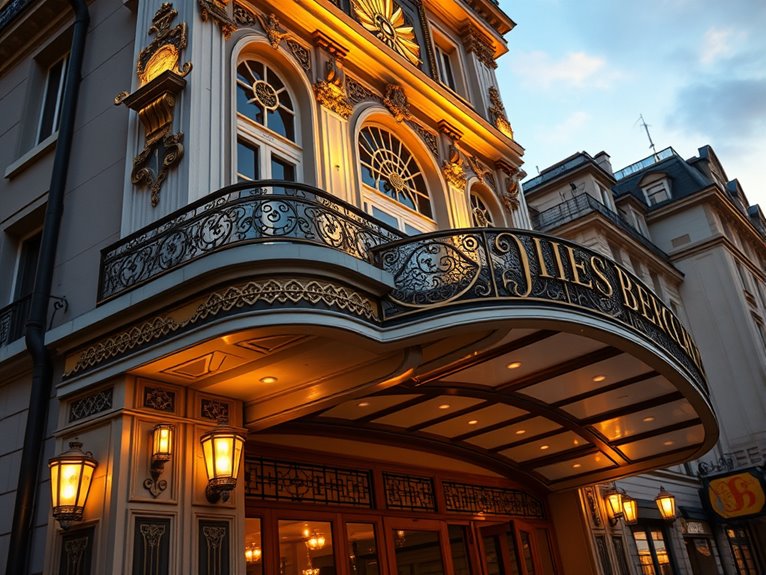
The Folies Bergère stands as one of Paris's most prestigious Art Deco entertainment venues, embodying the exuberant spirit of the 1920s and 1930s. Located in the 9th arrondissement, this historic music hall has been dazzling audiences since 1869, but its transformation during the Art Deco period created the iconic façade and interior that continue to captivate visitors today.
Maurice Pico's 1926 renovation brought the distinctive Art Deco elements that make the Folies Bergère a masterpiece of the style. The building showcases geometric patterns, stylized floral motifs, and the characteristic stepped forms of Art Deco architecture, while its interior features elaborate gold leaf details, dramatic lighting fixtures, and the famous mirrored foyer that inspired Manet's famous painting "A Bar at the Folies-Bergère."
Quick Facts:
- Opening Hours: Performance times vary; box office opens 11:00-19:00
- Ticket Prices: €30-120, depending on show and seating
- Photography: Generally prohibited during performances
- Dress Code: Smart casual to formal, depending on the event
- Best Viewing Times: Evening shows offer the most authentic experience
- Access: Metro stations Grands Boulevards or Cadet
The Iconic Façade
The building's exterior at 32 rue Richer presents a stunning example of Art Deco architectural design. The symmetrical façade features distinctive stepped geometric patterns, decorative metalwork, and illuminated signage that creates a dramatic effect at night. The entrance canopy, with its characteristic Art Deco typography and lighting, has become one of Paris's most photographed architectural elements.
The Historic Interior
The main auditorium maintains much of its original Art Deco splendor, including the elaborate ceiling designs, chrome detailing, and geometric patterns typical of the period. The famous grand staircase, adorned with Art Deco railings and light fixtures, offers a glimpse into the golden age of Parisian entertainment. Lesser-known are the private boxes, which feature original Art Deco-style furniture and decorative elements rarely seen by casual visitors.
The Mirror Foyer
Perhaps the most celebrated Art Deco feature is the mirror foyer, where the interplay of reflections and lighting creates an infinite visual effect. This space, with its geometric chandelier designs and brass detailing, exemplifies the luxury and sophistication of the Art Deco movement. Look for the hidden Art Deco motifs in the mirror frames, often overlooked by tourists.
Pro Tips:
To fully appreciate the Art Deco architecture, arrive at least 30 minutes before show time when the venue is less crowded. The best photographs of the exterior can be captured during the "blue hour" just after sunset when the building's lighting creates a dramatic effect against the darkening sky. Consider booking a historical tour (available on select days) to access areas normally closed to the public, including some remarkably preserved Art Deco dressing rooms.
Practical Advice:
When visiting the Folies Bergère, combine your visit with exploration of other Art Deco landmarks in the 9th arrondissement. Book tickets well in advance for popular shows, and consider the "historical tour" option if available. The venue's Art Deco features are best photographed during daylight hours or early evening, before the pre-show crowds arrive. Remember that while the exterior is freely accessible for photography, interior photography may require special permission.
Palais De La Porte Dorée
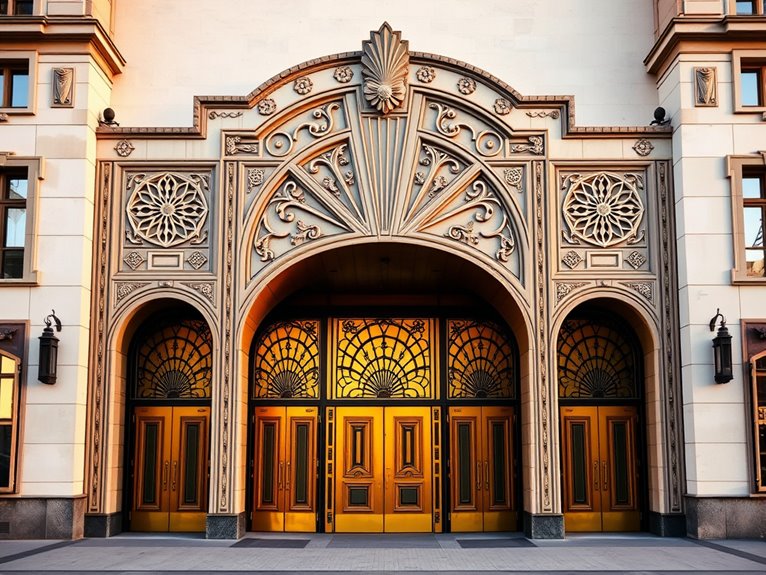
The Palais de la Porte Dorée stands as one of Paris's most striking examples of Art Deco architecture, built for the 1931 International Colonial Exhibition. This magnificent structure, designed by architect Albert Laprade, showcases an impressive fusion of Art Deco geometrical patterns and colonial-themed decorative elements that reflect both the architectural zeitgeist of the 1930s and France's complex colonial history.
Located in the 12th arrondissement, this architectural gem now houses the National Museum of Immigration History and the Tropical Aquarium. The building's exterior features remarkable bas-reliefs by Alfred Janniot, depicting scenes from French colonies, while the interior boasts stunning frescos, elaborate ironwork, and preserved period furniture that makes it an essential stop for architecture enthusiasts and history buffs alike.
Quick Facts:
- Opening Hours: Tuesday-Sunday, 10:00-17:30 (closed Mondays)
- Admission: €8-12 (combined ticket for museum and aquarium)
- Best Time to Visit: Weekday mornings for fewer crowds
- Photography: Allowed without flash
- Accessibility: Fully wheelchair accessible
- Metro: Porte Dorée (Line 8)
- Peak Season: April-October
Notable Features:
The monumental façade spans 110 meters and rises to nearly 18 meters, featuring Janniot's extraordinary bas-reliefs carved from Lens stone. The detailed sculptural work represents one of the largest and most ambitious Art Deco relief programs ever created, taking over a year to complete. Insider tip: Visit during late afternoon when the sun casts dramatic shadows across the reliefs, creating stunning photo opportunities.
The Forum:
The building's central hall, known as the Forum, showcases elaborate frescos by Pierre-Henri Ducos de la Haille. The space features original Art Deco lighting fixtures and furniture, with an intricate marble floor pattern that mirrors the geometric themes found throughout the building. Little-known fact: The original wooden parquet floors are still preserved beneath the current flooring.
Pro Tips:
For the best experience, visit on Thursday mornings when guided tours (in French and English) provide access to normally restricted areas, including the former library and conference rooms with their original Art Deco furnishings. Photographers should bring wide-angle lenses to capture the expansive façade and interior spaces. The building's orientation means morning light is best for exterior shots, while afternoon light creates dramatic effects in the Forum.
Practical Advice:
Combine your visit with a stroll through the adjacent Bois de Vincennes for a full day of architecture and nature. Purchase tickets online to avoid queues, especially during peak season. The museum's café offers a pleasant spot for lunch with views of the surrounding area, but consider booking a table in advance during weekends. Keep in mind that some exhibition texts are primarily in French, so downloading the English audio guide app before your visit is recommended.
Église Du Saint-Esprit
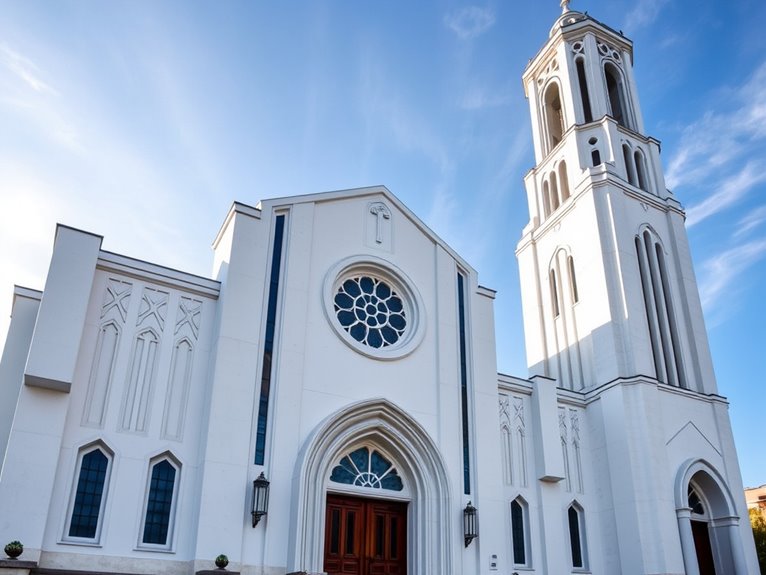
The Église Du Saint-Esprit stands as one of Paris's most striking examples of Art Deco religious architecture, breaking from traditional Gothic and Romanesque church designs that dominate the city's landscape. Completed in 1935 by architect Paul Tournon, this remarkable church showcases how modern architectural movements could be successfully adapted for sacred spaces, creating a unique fusion of contemporary design and spiritual atmosphere.
Located in the 12th arrondissement, this church represents a bold departure from conventional church architecture while maintaining religious symbolism through its innovative use of materials and geometric patterns. The building's distinctive octagonal tower, reaching 75 meters high, has become an architectural landmark that draws both architecture enthusiasts and religious visitors, offering a unique perspective on 1930s religious architecture in Paris.
Quick Facts:
- Opening Hours: 9:00 AM – 7:00 PM daily
- Mass Times: Sunday at 10:30 AM and 6:30 PM
- Photography: Allowed without flash
- Admission: Free
- Best Visiting Time: Early morning for ideal natural light
- Accessibility: Wheelchair accessible
- Address: 186 Avenue Daumesnil, 75012 Paris
Key Features:
The most striking element of Église Du Saint-Esprit is its reinforced concrete construction, featuring an octagonal layout that creates a central space topped by a remarkable dome. The interior showcases an extensive collection of Art Deco religious artwork, including Maurice Denis's masterful frescoes and remarkable stained glass windows designed by Maurice Gaudin. The church's innovative use of concrete and geometric patterns demonstrates how modern materials could create sacred spaces that feel both contemporary and timeless.
Insider Tip: Visit during the morning hours when sunlight streams through the eastern windows, creating spectacular light effects through the geometric stained glass patterns. The best photos can be captured between 9:30 AM and 11:00 AM when the morning light illuminates the interior artwork.
Pro Tips:
The church hosts occasional concerts and cultural events that showcase its exceptional acoustics and architectural features. Check the parish bulletin board near the entrance for upcoming events, as these occasions offer unique opportunities to experience the space differently. Additionally, the church is less crowded during weekday afternoons, allowing for peaceful contemplation and unobstructed views of the architectural details.
Practical Advice:
When visiting, wear appropriate attire as this is an active place of worship. The surrounding 12th arrondissement offers several cafes and restaurants, making it ideal to combine your visit with exploring the local neighborhood. The church is easily accessible via Metro line 8 (Daumesnil station) or line 6 (Nation station), and visitors are encouraged to respect ongoing religious services while photographing or touring the space.
